Difference between revisions of "Reisekamera"
(→The common tailboard variant) |
m (→Makers of similar cameras, named "travel camera", "chambre de voyage" or else: added link for FKD) |
||
| (76 intermediate revisions by 6 users not shown) | |||
| Line 1: | Line 1: | ||
| − | {{ | + | {{glossary}} |
| + | <div class="floatright plainlinks" style="margin:0px 0px 15px 15px;"> | ||
| + | {{Flickr_image | ||
| + | |image_source= https://www.flickr.com/photos/danipuntocom/15132293999/ | ||
| + | |image= http://farm6.staticflickr.com/5567/15132293999_ce67280a76_n_d.jpg | ||
| + | |image_align= right | ||
| + | |image_text= [[Stegemann]] Reisekamera | ||
| + | |image_by= Danipuntocom | ||
| + | |image_rights= nc | ||
| + | }} | ||
| + | </div> | ||
| + | A '''Reisekamera''' or '''chambre de voyage''' (German and French for 'travel camera') is a wooden bellows plate camera. Reisekameras are a subgroup of the 19th century wooden [[field camera]]s. Most collectors associate the term with a distinct kind of [[tailboard camera]] architecture, but some of these travel cameras had front panel focusing instead of the tailboard cameras' rear focusing. Originally Reisekameras were intended for professionals, as tools for applications outside the studio, for portraiture, architectural work or documentation away from the studio, in gardens, homes or museums. Most [[photographer]]s didn't own a big carriage, and needed a light collapsible camera for field work. They also had to carry a tripod and, in the early years, a dark tent, chemicals and trays for preparation and development of the plates for the [[wet-collodion]] process. Of course this camera conception became more and more popular among amateurs, especially after [[dry plates]] became available. | ||
| − | ''' | + | The Reisekamera, believed to have originated in central Europe, influenced by, and to a high degree perfected in Germany from 1860<ref>Kleffe & Langner: "Historische Kameras"</ref>, reached its peak popularity between 1895 and 1914. The common tailboard variant distinguishes itself from other [[tailboard camera]]s most notably by the hinged baseboard upon which the [[ground glass back]] can be moved and fixed, and which is the same width as the camera's front and back. This type was also known as '''continental view''' (meaning "continental type of [[view camera]]"). |
| − | + | The Reisekamera was quite popular in Europe for several decades around 1900. Centres of its production were Görlitz, [[Dresden]], Vienna and the French-German Alsace region. It was produced until the 1980s (Soviet [[FKD view cameras]]). The camera type stayed in use for purposes like school class photos. | |
| − | + | {{Flickr image | |
| − | + | | image_source=http://www.flickr.com/photos/mario_groleau/2297117110/in/pool-camerawiki | |
| − | + | | image=http://farm4.static.flickr.com/3042/2297117110_0aa2f84e93_m.jpg | |
| − | + | | image_align=right | |
| − | + | | image_text=collapsed camera on [[tripod]] | |
| − | + | | image_by=Mario Groleau | |
| − | + | | image_rights=wp | |
| − | + | }} | |
| − | + | <br style="clear:left"/> | |
| − | |||
| − | |||
| − | |||
In 1892 Josef Maria Eder, professor for photo chemistry at the University of Vienna, described the Reisekamera<ref>Kleffe & Langner: "Historische Kameras"</ref>: | In 1892 Josef Maria Eder, professor for photo chemistry at the University of Vienna, described the Reisekamera<ref>Kleffe & Langner: "Historische Kameras"</ref>: | ||
| Line 25: | Line 33: | ||
# bellows extension at least double as long as the longest side of the maximum image format | # bellows extension at least double as long as the longest side of the maximum image format | ||
# usabilty also with short bellows extension and wide angle lens | # usabilty also with short bellows extension and wide angle lens | ||
| − | Tiltable backs and | + | Tiltable backs and lens boards were described by Eder as extra features of expensive models. His definition of the Reisekamera fits for the common tailboard variant as well as for the front focusing models. |
| − | Later a lens | + | Later a lens plate allowing vertical and horizontal shifts plus a tiltable camera back were features of typical tailboard Reisekameras. |
| − | + | Reisekameras are view cameras. Thus their rear panel takes the [[plate|plate holder]] which is interchangeable with a [[Ground glass back|focusing screen back]]. Some even have a rotatable back. [[Adapters]] for film packs or even for [[roll film]] were available for the cameras, as well as attachable plate magazines. The cameras' light-tight [[bellows]] were made of leather or good calico<ref>Dr. E. Vogels Taschenbuch der Photographie (1910)</ref>. | |
| − | + | ||
| + | ===The common tailboard Reisekamera=== | ||
{{Flickr image | {{Flickr image | ||
| − | | image_source=http://www.flickr.com/photos/89864432@N00/ | + | | image_source=http://www.flickr.com/photos/89864432@N00/3729914815/in/pool-camerawiki |
| − | | image=http://farm3.static.flickr.com/ | + | | image=http://farm3.static.flickr.com/2553/3729914815_5d5435739b_m.jpg |
| − | | image_align= | + | | image_align=right |
| − | | image_text= | + | | image_text=M - matte screen<br/>B - Bellows<br/>O - lens<br/>T - rack and pinion knurl<br/>S - tripod<br/> |
| − | + | | scan_by= Uwe Kulick | |
| − | + | | image_rights= with permission | |
| + | }} | ||
| + | The common variant of the Reisekamera is not comparable with the modern extremely flexible light field cameras. Some more wood was used for its design, giving it more weight and making it resembling contemporary atelier cameras. But unlike [[studio camera]]s the travel cameras are foldable for portability. | ||
{{Flickr image | {{Flickr image | ||
| − | | image_source=http://www.flickr.com/photos/89864432@N00/ | + | | image_source=http://www.flickr.com/photos/89864432@N00/3711059204/in/pool-camerawiki/ |
| − | | image=http:// | + | | image=http://farm6.static.flickr.com/5019/5487344602_03642056b7_m.jpg |
| image_align=left | | image_align=left | ||
| − | | image_text= | + | | image_text=a Reisekamera with<br/>accessory shutter upon lens<br/> |
| + | | scan_by= Uwe Kulick | ||
| + | | image_rights= with permission | ||
}} | }} | ||
| − | The shape of the Reisekamera's common tailboard form is distinctly square, having equally sized front- and rear-panels, both attached to an equally wide | + | The shape of the Reisekamera's common tailboard form is distinctly square, having equally sized front- and rear-panels, both attached to an equally wide baseboard. Either front and back is connected by a non-tapering bellows, or lens plate and back are connected by a narrow-throated tapering bellows. The front panel carries the movable lens plate and the tiltable rear panel takes the [[plate|plate holder]] which is interchangeable with a (often hinged) focusing screen. Focusing is carried out by sliding the rear panel along the base plate while observing the image on the screen, usually supported by a rack and pinion mechanism. The camera folds flat, after the rear panel is brought forward to the lens panel, by folding the hinged baseboard up covering the rear panel. |
| − | + | This common tailboard variant of the Reisekamera may have been derived from a very early collapsible camera design by camera maker Judge<ref>R.C.Smith: "Antique Cameras"</ref> or similar early constructions of portable cameras. It was collapsible just for portability, not for maximum compactness. It was intended as tool for outside the studio, as camera for the advanced amateur or as start equipment for photography students. It was available in different sizes. Many travel cameras were made for the common [[Plate Sizes|plate sizes]] 18x24cm and 13x18cm, but smaller and bigger sizes were available. Student cameras were made for the smaller 9x12cm plate format. The cameras required a sturdy [[tripod]] since they were not for snapshot photography like [[hand camera]]s. Thus they were all but ideal for travelers, voyageurs, Reisende, all but what their names travel camera, chambre de voyage and Reisekamera were promising. | |
| − | {{ | + | |
| − | | image_source=http://www.flickr.com/photos/ | + | {{Flickr_image |
| − | | image=http:// | + | |image_source= http://www.flickr.com/photos/fotosnostock/7348062046/in/pool-camerawiki/ |
| − | | image_align=right | + | |image= http://farm8.staticflickr.com/7234/7348062046_a4e4d4ceba_m.jpg |
| − | | image_text= | + | |image_align= right |
| + | |image_text= travel camera and plate-holder ready for journey | ||
| + | |image_by= Jürgen Schütz | ||
| + | |image_rights= wp | ||
}} | }} | ||
| − | |||
| − | The Reisekamera's tailboard variant is, regardless of the maker, quite similarly built and of almost standardised design. Generally there are a number of limited movements: at the back, the film plate may be tilted and turned slightly to adjust perspective | + | The Reisekamera's tailboard variant is, regardless of the maker, quite similarly built and of almost standardised design. Generally there are a number of limited movements: at the back, the film plate may be tilted and turned slightly to adjust perspective. The camera's lens plate may be mounted horizontally shiftable into another vertically shiftable board. If the bellows is fixed to the front, the lens plate may slide vertically and horizontally, without the bellows obstructing the light from the lens reaching the film, due to the non-tapering bellows, as opposed to common field cameras where the whole front is free to move as required, including the bellows. If the Reisekamera has a tapering bellows, the bellows' narrow front end follows the lens plate movements. |
| − | + | Usually the baseboard is extendible for close-up work and to accommodate various focal length lenses, the double extension feature. The tailboard construction is particularly favourable using wide-angle lenses and for close-up work since no part of the camera protrudes past the front panel. Many Reisekameras have a spirit level built into the baseboard. | |
| − | When using the camera a [[Ground glass back|black cloth]] is a helpful and often necessary requisite to keep stray light out while observing the image on the focusing screen. | + | Although the camera, when new, rarely was supplied with a shutter, the lens cap usually sufficed, some acquired an add-on shutter of one sort or another. Still, some of the most sophisticated Reisekameras were built with an integral [[focal plane shutter]], a huge mechanism incorporated in the rear panel, only the brass controls visible on either side. Some of the less sophisticated models are equipped with a simple built-in pneumatically remote-controlled [[shutter]] behind the lens mount. Simple gravity-controlled guillotine shutters were common accessories<ref>Kleffe & Langner: "Historische Kameras"</ref>. Accessory [[leaf shutter]]s were also available. A common camera upgrade was to mount a rouleau shutter between lens and lens plate. |
| + | |||
| + | {|class=plainlinks | ||
| + | ||[http://www.flickr.com/photos/mario_groleau/2296321477/in/pool-camerawiki http://farm4.static.flickr.com/3020/2296321477_88b5595cb2_m.jpg] | ||
| + | ||[http://www.flickr.com/photos/mario_groleau/2297117316/in/pool-camerawiki http://farm4.static.flickr.com/3172/2297117316_0488319fa3_m.jpg] | ||
| + | ||[http://www.flickr.com/photos/mario_groleau/2297117462/in/pool-camerawiki http://farm4.static.flickr.com/3148/2297117462_d35c372f49_m.jpg] | ||
| + | ||side view and [[lens board]] movements <br><small>images by {{image author|Mario Groleau}} </small>{{non-commercial}} | ||
| + | |} | ||
| + | |||
| + | When using the camera a [[Ground glass back|black cloth]] is a helpful and often necessary requisite to keep stray light out while observing the image on the focusing screen. When the picture is composed and focused, the focusing screen is replaced by the plate holder. The lens is covered with its cap, and the dark slide removed from the plate holder. When all is clear, the cap is removed for the required exposure time and replaced. If an auxiliary shutter is present, it may replace the function of the lens cap. The dark slide is replaced, and the plate holder is removed and brought to the darkroom for development and copying. | ||
| + | |||
| + | {{Flickr image | ||
| + | | image_source=http://www.flickr.com/photos/89864432@N00/3732304875/in/pool-camerawiki | ||
| + | | image=http://farm3.static.flickr.com/2564/3732304875_41b5ff28d3_m.jpg | ||
| + | | image_align=left | ||
| + | | image_text= Reisekamera<br/> | ||
| + | | scan_by= Uwe Kulick | ||
| + | | image_rights= pd | ||
| + | }} | ||
=== Other designs === | === Other designs === | ||
| − | Some Reisekameras were not designed as tailboard field cameras for rear focusing. Instead their focusing and all possible shift and maybe tilt movements | + | Some Reisekameras were not designed as tailboard field cameras for rear focusing. Instead their focusing and all possible shift and maybe tilt movements has to be done by moving and adjusting the lens board. The "Reisekamera" characteristics of this variant are a similar portability, rack and pinion focusing aid, and similar image formats and extendibility of bellows. Some had a similar limited set of possible movements<ref>Brockhaus Konversations-Lexikon (1895), picture table "Photographie II", simple front focusing model</ref> as known from the tailboard variant, others allowed tilting both, lens board and back<ref>Meyers Großes Konversations-Lexikon (1908), picture tables "Photographische Apparate", several sophisticated front focusing Reisekameras</ref>. Maybe the tailboard models of the Reisekamera became more successful because they were or just looked more sturdy. Renowned authors like Dr. E Vogel<ref>Dr. E. Vogels Taschenbuch der Photographie (1910)</ref> recommended to choose sturdy constructions instead of more flexible ones. |
| − | Of course a few makers offered more sophisticated [[field camera]] types as "Reisekamera", "travel camera", "chambre de voyage" etc., thus going far beyond the definition given here for | + | Of course a few makers offered more sophisticated [[field camera]] types as "Reisekamera", "travel camera", "chambre de voyage" etc., thus going far beyond the definition given here for the Reisekamera. |
| + | {{br}} | ||
=== Makers of the Reisekamera === | === Makers of the Reisekamera === | ||
| + | {{Flickr image | ||
| + | | image_source=http://www.flickr.com/photos/89864432@N00/2834258458/in/pool-camerawiki | ||
| + | | image=http://farm4.static.flickr.com/3244/2834258458_de99357bb2_m.jpg | ||
| + | | image_align=right | ||
| + | | image_text=Ernemann Berry<br/>as Union I ([[Stöckig]])<br/> | ||
| + | | scan_by= Uwe Kulick | ||
| + | | image_rights= with permission | ||
| + | }} | ||
*[[Eugen Loeber]] (Dresden) | *[[Eugen Loeber]] (Dresden) | ||
*[[Ihagee]] (Dresden) | *[[Ihagee]] (Dresden) | ||
| Line 72: | Line 114: | ||
**see also [[Emil Wünsche Reise-Cameras]] | **see also [[Emil Wünsche Reise-Cameras]] | ||
**see also [[Emil Wünsche Schüler-Apparat]] (student's camera) | **see also [[Emil Wünsche Schüler-Apparat]] (student's camera) | ||
| − | *Richard | + | *Richard Wittmann (Dresden) |
*[[Ernemann]] (Dresden) | *[[Ernemann]] (Dresden) | ||
| − | ** Ernemann | + | ** [[Berry]] |
| − | *Herbst & Firl (Görlitz) | + | ** [[Ernemann Lea|Lea]] |
| − | ** Ernemann Globus | + | *[[Huth]] (Dresden) |
| + | *[[Ferdinand Franz Meyer]] (Dresden) | ||
| + | *[[Unger & Hoffmann]] (Dresden) | ||
| + | *[[Herbst & Firl]] (Görlitz) | ||
| + | ** [[Globus|Ernemann Globus]] | ||
*[[Bentzin]] (Görlitz) | *[[Bentzin]] (Görlitz) | ||
| − | *Neue Görlitzer | + | *[[Neue Görlitzer Camera-Werke]] (Görlitz) |
*Max Wergien (Halle) | *Max Wergien (Halle) | ||
*[[Goerz]] (Berlin) | *[[Goerz]] (Berlin) | ||
*Sachs & Co. (Berlin) | *Sachs & Co. (Berlin) | ||
| + | {{Flickr_image | ||
| + | |image_source= http://www.flickr.com/photos/phollectormo/10852945914/in/pool-camerawiki | ||
| + | |image= http://farm4.staticflickr.com/3808/10852945914_0d7091bbfa_m.jpg | ||
| + | |image_align= right | ||
| + | |image_text= two Reisekameras with modern lenses | ||
| + | |image_by= phollectormo | ||
| + | |image_rights= wp | ||
| + | }} | ||
*Falz & Werner (Leipzig) | *Falz & Werner (Leipzig) | ||
*Annacker (Köln) | *Annacker (Köln) | ||
| − | *Voigtländer (Braunschweig) | + | *[[Voigtländer]] (Braunschweig) |
*Deuber & Rau (Nuremberg) | *Deuber & Rau (Nuremberg) | ||
*Hess & Sattler (Wiesbaden) | *Hess & Sattler (Wiesbaden) | ||
*[[E. Suter]] (Basel) | *[[E. Suter]] (Basel) | ||
| − | *Georg Faltus (Vienna) | + | *[[Faltus|Georg Faltus]] (Vienna) |
*Rudolf Lechner (Vienna) | *Rudolf Lechner (Vienna) | ||
*Josef Wanaus (Vienna) | *Josef Wanaus (Vienna) | ||
| Line 95: | Line 149: | ||
*Georg Joseph (Vienna) | *Georg Joseph (Vienna) | ||
*Alfred Werner (Vienna) | *Alfred Werner (Vienna) | ||
| + | *[[Mazo|E. Mazo]] (Paris) | ||
| + | |||
| + | {{Flickr image | ||
| + | | image_source=http://www.flickr.com/photos/lucispictor-photo/3069058942/in/pool-camerawiki | ||
| + | | image=http://farm4.static.flickr.com/3017/3069058942_635787c0f6_m.jpg | ||
| + | | image_align=right | ||
| + | | image_text=an FKD? | ||
| + | | image_by=LucisPictor | ||
| + | | image_rights=with permission | ||
| + | }} | ||
=== Makers of similar cameras, named "travel camera", "chambre de voyage" or else === | === Makers of similar cameras, named "travel camera", "chambre de voyage" or else === | ||
| − | *Ferdinand Franz Meyer (Dresden) | + | *[[Ferdinand Franz Meyer]] (Dresden) |
*[[J. Lancaster & Son]] (Birmingham) | *[[J. Lancaster & Son]] (Birmingham) | ||
*Stereoscopic Co. Ltd. (London) | *Stereoscopic Co. Ltd. (London) | ||
*[[Compagnie Française de Photographie]] | *[[Compagnie Française de Photographie]] | ||
| − | *Derogy (Paris) | + | *[[Derogy]] (Paris) |
*Gilles (Paris) | *Gilles (Paris) | ||
| − | *Mackenstein (Paris) | + | *[[Mackenstein]] (Paris) |
| − | *FKD (Kharkov) | + | *[[FKD view cameras]] (Kharkov) |
Several makers made a different type of Reisekamera or travel camera, with a fixed rear and a smaller sliding front standard that allows shift AND often also tilt movements. | Several makers made a different type of Reisekamera or travel camera, with a fixed rear and a smaller sliding front standard that allows shift AND often also tilt movements. | ||
| + | |||
| + | {{Flickr image | ||
| + | | image_source=http://www.flickr.com/photos/89864432@N00/3749784007/in/pool-camerawiki | ||
| + | | image=http://farm3.static.flickr.com/2590/3749784007_6cecc40bb5_m.jpg | ||
| + | | image_align=right | ||
| + | | image_text= Reisekamera<br/> | ||
| + | | scan_by= Uwe Kulick | ||
| + | | image_rights= pd | ||
| + | }} | ||
=== Makers of the fixed rear design === | === Makers of the fixed rear design === | ||
| − | *[[Voigtländer]] (Braunschweig) <ref>Voigtländer Reisekamera of 1890 in | + | *[[Voigtländer]] (Braunschweig) <ref>Voigtländer Reisekamera of 1890 in {{Abring|volume=1|page=55|image=134}}</ref> |
*Josef Vojta (Prague)<ref>Vojta Reisekamera in: see links, "Josef Vojta (Prague)"</ref> | *Josef Vojta (Prague)<ref>Vojta Reisekamera in: see links, "Josef Vojta (Prague)"</ref> | ||
*[[Ernemann]] (Dresden) <ref>Ernemann Windsor Reisekamera in: Kirsten Vincenz, Wolfgang Hesse: "Fotoindustrie und Bilderwelten"</ref> | *[[Ernemann]] (Dresden) <ref>Ernemann Windsor Reisekamera in: Kirsten Vincenz, Wolfgang Hesse: "Fotoindustrie und Bilderwelten"</ref> | ||
| Line 119: | Line 192: | ||
*[[Houghton_and_Ensign|Houghtons]] (London) | *[[Houghton_and_Ensign|Houghtons]] (London) | ||
*[[Gaumont]] (Paris) | *[[Gaumont]] (Paris) | ||
| − | * | + | *[[Mackenstein]] (Paris) |
*[[Goldmann|R. A. Goldmann]] (Vienna) | *[[Goldmann|R. A. Goldmann]] (Vienna) | ||
| − | === Links === | + | ==Notes== |
| − | *[http://www.designundphoto.de/seite%20ca0327%20vojta%20reisekamera.htm Josef Vojta, alternate "Reisekamera" design], at | + | <references/> |
| − | *[http://www.kameramuseum.de/0-fotokameras/grossbild/holz-platte/reisekamera-holz.html Deuber & Rau Reisekamera] and [http://www.kameramuseum.de/0-fotokameras/grossbild/holz-platte2/index.html "no-name" Reisekamera] at | + | == Links == |
| − | *[http://www.antiquewoodcameras.com/euro1. | + | {{Flickr_image |
| − | *[ | + | |image_source= http://www.flickr.com/photos/uwe_kulick/5849023330/in/pool-camerawiki |
| − | + | |image= http://farm4.static.flickr.com/3356/5849023330_3af0130bf8_m.jpg | |
| − | + | |image_align= right | |
| − | + | |image_text= collapsed Reisekamera | |
| + | |image_by= Uwe Kulick | ||
| + | |image_rights= wp | ||
| + | }} | ||
| + | *[https://web.archive.org/web/20170912165443/http://www.designundphoto.de/seite%20ca0327%20vojta%20reisekamera.htm Josef Vojta, alternate "Reisekamera" design], at [https://web.archive.org/web/20160410055012/http://designundphoto.de/2.seite.htm Design und Photo] (archived) | ||
| + | *[http://www.kameramuseum.de/0-fotokameras/grossbild/holz-platte/reisekamera-holz.html Deuber & Rau Reisekamera] and [http://www.kameramuseum.de/0-fotokameras/grossbild/holz-platte2/index.html "no-name" Reisekamera] at [http://www.kameramuseum.de Kurt Tauber's] | ||
| + | *[http://www.antiquewoodcameras.com/euro1.html chambre de voyage, common tailboard architecture, explanation of ''Continental View'' type], on [http://www.antiquewoodcameras.com Antique Wood Cameras] | ||
| + | *[https://web.archive.org/web/20170124001301/http://ksammlung.horst-reimer.de/Reisekamera/ Reisekamera, unknown maker], at [https://web.archive.org/web/20170707033504/http://ksammlung.horst-reimer.de/ Horst Reimer's] (archived) | ||
| − | |||
| − | |||
| − | [[Category:View | + | [[Category:View cameras]] |
[[Category:Camera architecture]] | [[Category:Camera architecture]] | ||
| − | |||
| − | |||
Latest revision as of 07:43, 10 August 2023

|
| Stegemann Reisekamera image by Danipuntocom (Image rights) |
A Reisekamera or chambre de voyage (German and French for 'travel camera') is a wooden bellows plate camera. Reisekameras are a subgroup of the 19th century wooden field cameras. Most collectors associate the term with a distinct kind of tailboard camera architecture, but some of these travel cameras had front panel focusing instead of the tailboard cameras' rear focusing. Originally Reisekameras were intended for professionals, as tools for applications outside the studio, for portraiture, architectural work or documentation away from the studio, in gardens, homes or museums. Most photographers didn't own a big carriage, and needed a light collapsible camera for field work. They also had to carry a tripod and, in the early years, a dark tent, chemicals and trays for preparation and development of the plates for the wet-collodion process. Of course this camera conception became more and more popular among amateurs, especially after dry plates became available.
The Reisekamera, believed to have originated in central Europe, influenced by, and to a high degree perfected in Germany from 1860[1], reached its peak popularity between 1895 and 1914. The common tailboard variant distinguishes itself from other tailboard cameras most notably by the hinged baseboard upon which the ground glass back can be moved and fixed, and which is the same width as the camera's front and back. This type was also known as continental view (meaning "continental type of view camera").
The Reisekamera was quite popular in Europe for several decades around 1900. Centres of its production were Görlitz, Dresden, Vienna and the French-German Alsace region. It was produced until the 1980s (Soviet FKD view cameras). The camera type stayed in use for purposes like school class photos.
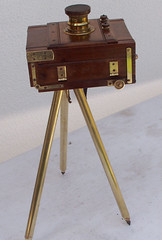
|
| collapsed camera on tripod image by Mario Groleau (Image rights) |
In 1892 Josef Maria Eder, professor for photo chemistry at the University of Vienna, described the Reisekamera[2]:
- light weight, moderate dimensions
- sturdy construction
- safe-keeping of the focusing screen from moisture and dirt
- lens board allowing vertical shifts
- bellows extension at least double as long as the longest side of the maximum image format
- usabilty also with short bellows extension and wide angle lens
Tiltable backs and lens boards were described by Eder as extra features of expensive models. His definition of the Reisekamera fits for the common tailboard variant as well as for the front focusing models.
Later a lens plate allowing vertical and horizontal shifts plus a tiltable camera back were features of typical tailboard Reisekameras.
Reisekameras are view cameras. Thus their rear panel takes the plate holder which is interchangeable with a focusing screen back. Some even have a rotatable back. Adapters for film packs or even for roll film were available for the cameras, as well as attachable plate magazines. The cameras' light-tight bellows were made of leather or good calico[3].
Contents
- 1 The common tailboard Reisekamera
- 2 Other designs
- 3 Makers of the Reisekamera
- 4 Makers of similar cameras, named "travel camera", "chambre de voyage" or else
- 5 Makers of the fixed rear design
- 6 makers of more sophisticated field cameras sold as "travel camera", "Reisekamera" or "chambre de voyage"
- 7 Notes
- 8 Links
The common tailboard Reisekamera
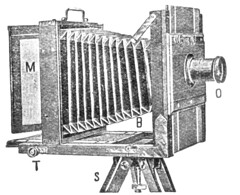
|
| M - matte screen B - Bellows O - lens T - rack and pinion knurl S - tripod scanned by Uwe Kulick (Image rights) |
The common variant of the Reisekamera is not comparable with the modern extremely flexible light field cameras. Some more wood was used for its design, giving it more weight and making it resembling contemporary atelier cameras. But unlike studio cameras the travel cameras are foldable for portability.
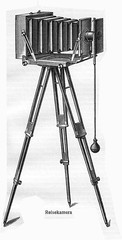
|
| a Reisekamera with accessory shutter upon lens scanned by Uwe Kulick (Image rights) |
The shape of the Reisekamera's common tailboard form is distinctly square, having equally sized front- and rear-panels, both attached to an equally wide baseboard. Either front and back is connected by a non-tapering bellows, or lens plate and back are connected by a narrow-throated tapering bellows. The front panel carries the movable lens plate and the tiltable rear panel takes the plate holder which is interchangeable with a (often hinged) focusing screen. Focusing is carried out by sliding the rear panel along the base plate while observing the image on the screen, usually supported by a rack and pinion mechanism. The camera folds flat, after the rear panel is brought forward to the lens panel, by folding the hinged baseboard up covering the rear panel.
This common tailboard variant of the Reisekamera may have been derived from a very early collapsible camera design by camera maker Judge[4] or similar early constructions of portable cameras. It was collapsible just for portability, not for maximum compactness. It was intended as tool for outside the studio, as camera for the advanced amateur or as start equipment for photography students. It was available in different sizes. Many travel cameras were made for the common plate sizes 18x24cm and 13x18cm, but smaller and bigger sizes were available. Student cameras were made for the smaller 9x12cm plate format. The cameras required a sturdy tripod since they were not for snapshot photography like hand cameras. Thus they were all but ideal for travelers, voyageurs, Reisende, all but what their names travel camera, chambre de voyage and Reisekamera were promising.
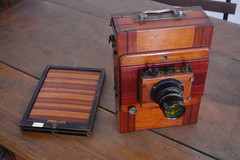
|
| travel camera and plate-holder ready for journey image by Jürgen Schütz (Image rights) |
The Reisekamera's tailboard variant is, regardless of the maker, quite similarly built and of almost standardised design. Generally there are a number of limited movements: at the back, the film plate may be tilted and turned slightly to adjust perspective. The camera's lens plate may be mounted horizontally shiftable into another vertically shiftable board. If the bellows is fixed to the front, the lens plate may slide vertically and horizontally, without the bellows obstructing the light from the lens reaching the film, due to the non-tapering bellows, as opposed to common field cameras where the whole front is free to move as required, including the bellows. If the Reisekamera has a tapering bellows, the bellows' narrow front end follows the lens plate movements.
Usually the baseboard is extendible for close-up work and to accommodate various focal length lenses, the double extension feature. The tailboard construction is particularly favourable using wide-angle lenses and for close-up work since no part of the camera protrudes past the front panel. Many Reisekameras have a spirit level built into the baseboard.
Although the camera, when new, rarely was supplied with a shutter, the lens cap usually sufficed, some acquired an add-on shutter of one sort or another. Still, some of the most sophisticated Reisekameras were built with an integral focal plane shutter, a huge mechanism incorporated in the rear panel, only the brass controls visible on either side. Some of the less sophisticated models are equipped with a simple built-in pneumatically remote-controlled shutter behind the lens mount. Simple gravity-controlled guillotine shutters were common accessories[5]. Accessory leaf shutters were also available. A common camera upgrade was to mount a rouleau shutter between lens and lens plate.
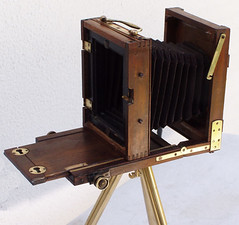
|

|

|
side view and lens board movements images by Mario Groleau (Image rights) |
When using the camera a black cloth is a helpful and often necessary requisite to keep stray light out while observing the image on the focusing screen. When the picture is composed and focused, the focusing screen is replaced by the plate holder. The lens is covered with its cap, and the dark slide removed from the plate holder. When all is clear, the cap is removed for the required exposure time and replaced. If an auxiliary shutter is present, it may replace the function of the lens cap. The dark slide is replaced, and the plate holder is removed and brought to the darkroom for development and copying.

|
| Reisekamera scanned by Uwe Kulick (Image rights) |
Other designs
Some Reisekameras were not designed as tailboard field cameras for rear focusing. Instead their focusing and all possible shift and maybe tilt movements has to be done by moving and adjusting the lens board. The "Reisekamera" characteristics of this variant are a similar portability, rack and pinion focusing aid, and similar image formats and extendibility of bellows. Some had a similar limited set of possible movements[6] as known from the tailboard variant, others allowed tilting both, lens board and back[7]. Maybe the tailboard models of the Reisekamera became more successful because they were or just looked more sturdy. Renowned authors like Dr. E Vogel[8] recommended to choose sturdy constructions instead of more flexible ones.
Of course a few makers offered more sophisticated field camera types as "Reisekamera", "travel camera", "chambre de voyage" etc., thus going far beyond the definition given here for the Reisekamera.
Makers of the Reisekamera

|
| Ernemann Berry as Union I (Stöckig) scanned by Uwe Kulick (Image rights) |
- Eugen Loeber (Dresden)
- Ihagee (Dresden)
- Emil Wünsche (Dresden)
- see also Emil Wünsche Reise-Cameras
- see also Emil Wünsche Schüler-Apparat (student's camera)
- Richard Wittmann (Dresden)
- Ernemann (Dresden)
- Huth (Dresden)
- Ferdinand Franz Meyer (Dresden)
- Unger & Hoffmann (Dresden)
- Herbst & Firl (Görlitz)
- Bentzin (Görlitz)
- Neue Görlitzer Camera-Werke (Görlitz)
- Max Wergien (Halle)
- Goerz (Berlin)
- Sachs & Co. (Berlin)
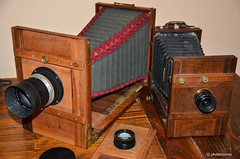
|
| two Reisekameras with modern lenses image by phollectormo (Image rights) |
- Falz & Werner (Leipzig)
- Annacker (Köln)
- Voigtländer (Braunschweig)
- Deuber & Rau (Nuremberg)
- Hess & Sattler (Wiesbaden)
- E. Suter (Basel)
- Georg Faltus (Vienna)
- Rudolf Lechner (Vienna)
- Josef Wanaus (Vienna)
- Felix Neumann (Vienna)
- A. Moll (Vienna)
- Georg Joseph (Vienna)
- Alfred Werner (Vienna)
- E. Mazo (Paris)
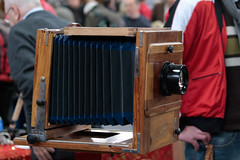
|
| an FKD? image by LucisPictor (Image rights) |
Makers of similar cameras, named "travel camera", "chambre de voyage" or else
- Ferdinand Franz Meyer (Dresden)
- J. Lancaster & Son (Birmingham)
- Stereoscopic Co. Ltd. (London)
- Compagnie Française de Photographie
- Derogy (Paris)
- Gilles (Paris)
- Mackenstein (Paris)
- FKD view cameras (Kharkov)
Several makers made a different type of Reisekamera or travel camera, with a fixed rear and a smaller sliding front standard that allows shift AND often also tilt movements.
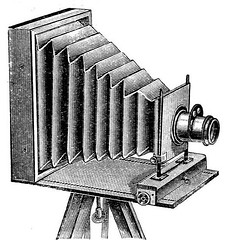
|
| Reisekamera scanned by Uwe Kulick (Image rights) |
Makers of the fixed rear design
- Voigtländer (Braunschweig) [9]
- Josef Vojta (Prague)[10]
- Ernemann (Dresden) [11]
- Ernemann Windsor
- Falz & Werner (Leipzig)[12]
- R. A. Goldmann (Vienna) [13]
makers of more sophisticated field cameras sold as "travel camera", "Reisekamera" or "chambre de voyage"
- Houghtons (London)
- Gaumont (Paris)
- Mackenstein (Paris)
- R. A. Goldmann (Vienna)
Notes
- ↑ Kleffe & Langner: "Historische Kameras"
- ↑ Kleffe & Langner: "Historische Kameras"
- ↑ Dr. E. Vogels Taschenbuch der Photographie (1910)
- ↑ R.C.Smith: "Antique Cameras"
- ↑ Kleffe & Langner: "Historische Kameras"
- ↑ Brockhaus Konversations-Lexikon (1895), picture table "Photographie II", simple front focusing model
- ↑ Meyers Großes Konversations-Lexikon (1908), picture tables "Photographische Apparate", several sophisticated front focusing Reisekameras
- ↑ Dr. E. Vogels Taschenbuch der Photographie (1910)
- ↑ Voigtländer Reisekamera of 1890 in Abring, H. D.: Von Daguerre bis heute Vol. 1, Herne 1990 , page 55 , image No. 134
- ↑ Vojta Reisekamera in: see links, "Josef Vojta (Prague)"
- ↑ Ernemann Windsor Reisekamera in: Kirsten Vincenz, Wolfgang Hesse: "Fotoindustrie und Bilderwelten"
- ↑ Falz&Werner camera (or similar of Ernemann) in Auktionshaus Cornwall, catalogue: "32. Photographica-Auktion"
- ↑ Goldmann Reisekamera Austrian Cameras site
Links
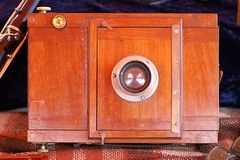
|
| collapsed Reisekamera image by Uwe Kulick (Image rights) |
- Josef Vojta, alternate "Reisekamera" design, at Design und Photo (archived)
- Deuber & Rau Reisekamera and "no-name" Reisekamera at Kurt Tauber's
- chambre de voyage, common tailboard architecture, explanation of Continental View type, on Antique Wood Cameras
- Reisekamera, unknown maker, at Horst Reimer's (archived)